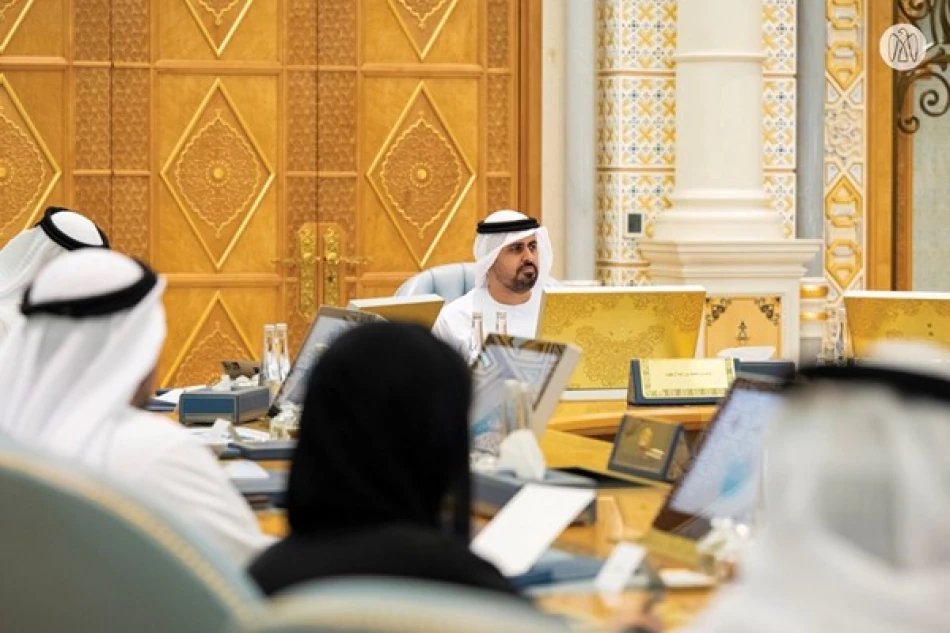
Sheikh Dhiyab Chairs International Humanitarian Affairs Council's Second Meeting
UAE Doubles Down on Humanitarian Leadership with Strategic Foreign Aid Overhaul
The United Arab Emirates is positioning itself as a global humanitarian superpower through a comprehensive restructuring of its foreign aid strategy, signaling a shift from ad-hoc assistance to systematic, long-term development partnerships. The move comes as traditional Western donors face budget constraints and growing domestic pressures, creating an opening for Gulf states to expand their international influence through strategic philanthropy.
Strategic Vision Beyond Traditional Aid
Sheikh Dhiyab bin Mohamed bin Zayed Al Nahyan, Deputy Chairman of the Presidential Court for Development Affairs and Martyrs' Families, chaired the second meeting of the International Humanitarian Affairs Council for 2025, where officials outlined an ambitious roadmap for the UAE's external assistance sector. The discussions centered on the 2024 Foreign Aid Report and capacity-building programs designed to professionalize the humanitarian sector.
The emphasis on aligning UAE humanitarian programs with national priorities while meeting global Sustainable Development Goals represents a calculated approach to soft power projection. Unlike traditional donor countries that often separate humanitarian aid from strategic interests, the UAE is openly integrating both objectives—a model increasingly adopted by emerging economies seeking greater international influence.
Professionalization of Humanitarian Operations
Building Institutional Expertise
The council reviewed the "Humanitarian Work Foresight Program," designed to develop leadership capabilities across various organizational levels within the humanitarian sector. This initiative reflects a broader trend among Gulf states to move beyond checkbook diplomacy toward building sustainable institutional capacity.
The program aims to equip professionals with cutting-edge knowledge and technical expertise in humanitarian and development work, addressing a critical gap in the region's approach to international assistance. Historically, Gulf humanitarian efforts have been criticized for lacking the institutional depth and technical expertise of established Western aid organizations.
Academic Partnerships and Credential Building
The council's support for a Master of Arts program in Humanitarian Affairs at the Anwar Gargash Diplomatic Academy represents a significant investment in long-term capacity building. This academic initiative targets decision-making skills, multicultural team management, and humanitarian program administration—competencies essential for competing with established international aid organizations.
The curriculum's focus on development studies within the context of international relations and diplomatic affairs suggests the UAE views humanitarian work as inseparable from broader foreign policy objectives, a pragmatic approach that contrasts with the traditional Western model of separating humanitarian and political agendas.
Regional Competition and Global Positioning
The UAE's humanitarian strategy must be understood within the context of intense regional competition for influence. Saudi Arabia's Vision 2030 includes substantial international development commitments, while Qatar has leveraged humanitarian assistance to rebuild its regional standing following the 2017-2021 blockade. The UAE's systematic approach to professionalizing its humanitarian sector suggests recognition that sustainable influence requires more than financial resources alone.
This competition mirrors broader shifts in international development, where emerging economies are challenging traditional donor hierarchies. China's Belt and Road Initiative and Turkey's humanitarian diplomacy have demonstrated how strategic aid can reshape global relationships, providing a template for Gulf states seeking expanded international roles.
Implications for Global Humanitarian Architecture
The UAE's emphasis on sustainable development solutions and long-term partnerships signals a potential shift away from emergency-focused humanitarian responses toward structural development interventions. This approach aligns with growing criticism of traditional humanitarian aid for creating dependency rather than fostering self-sufficiency.
For international organizations and traditional donors, the UAE's professionalization efforts represent both opportunity and challenge. While increased funding and expertise benefit global humanitarian efforts, the integration of humanitarian work with national foreign policy objectives may complicate coordination and standard-setting efforts within the international humanitarian system.
The success of this strategy will likely influence other Gulf states and emerging economies to adopt similar approaches, potentially reshaping the global humanitarian landscape toward more explicitly strategic and nationally-aligned assistance models.
Most Viewed News

 Layla Al Mansoori
Layla Al Mansoori






